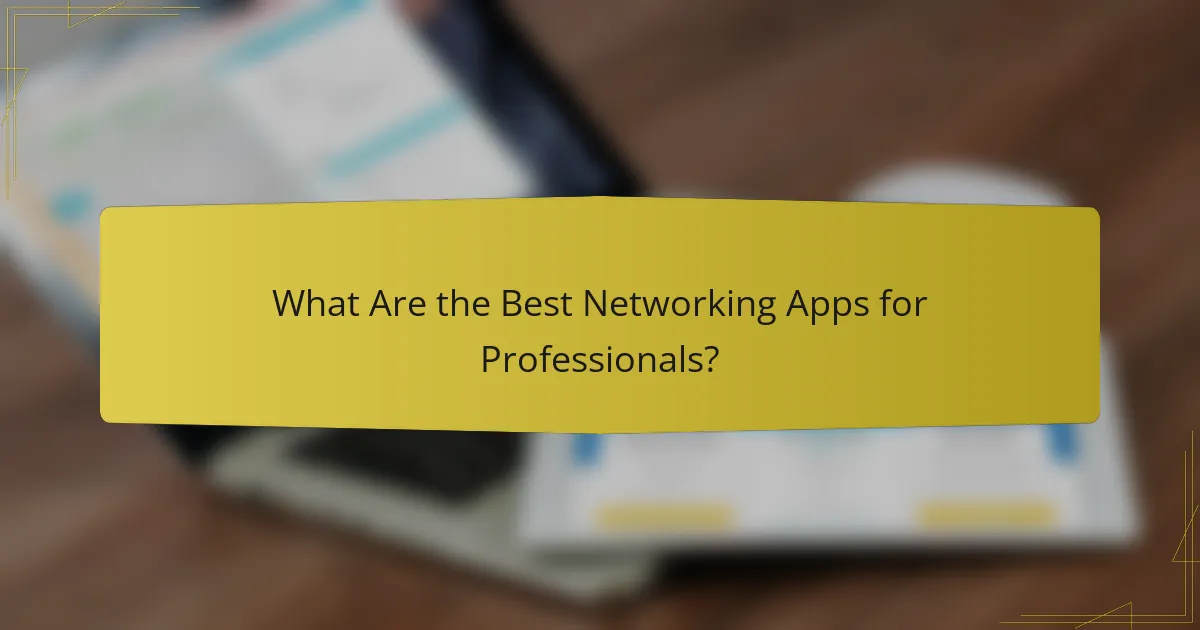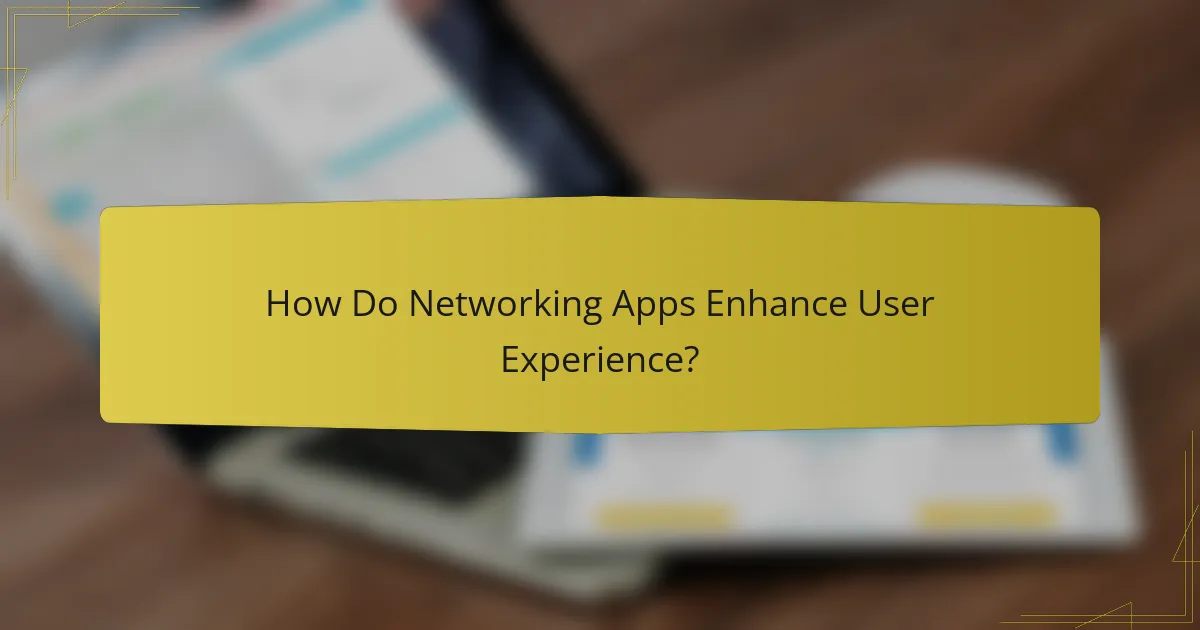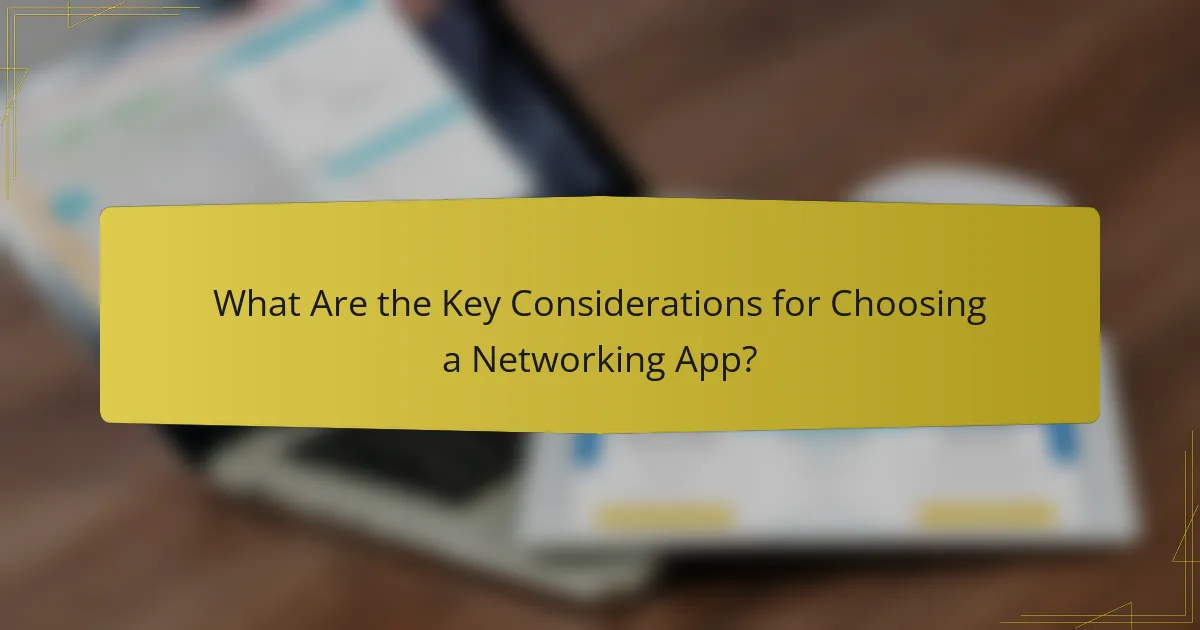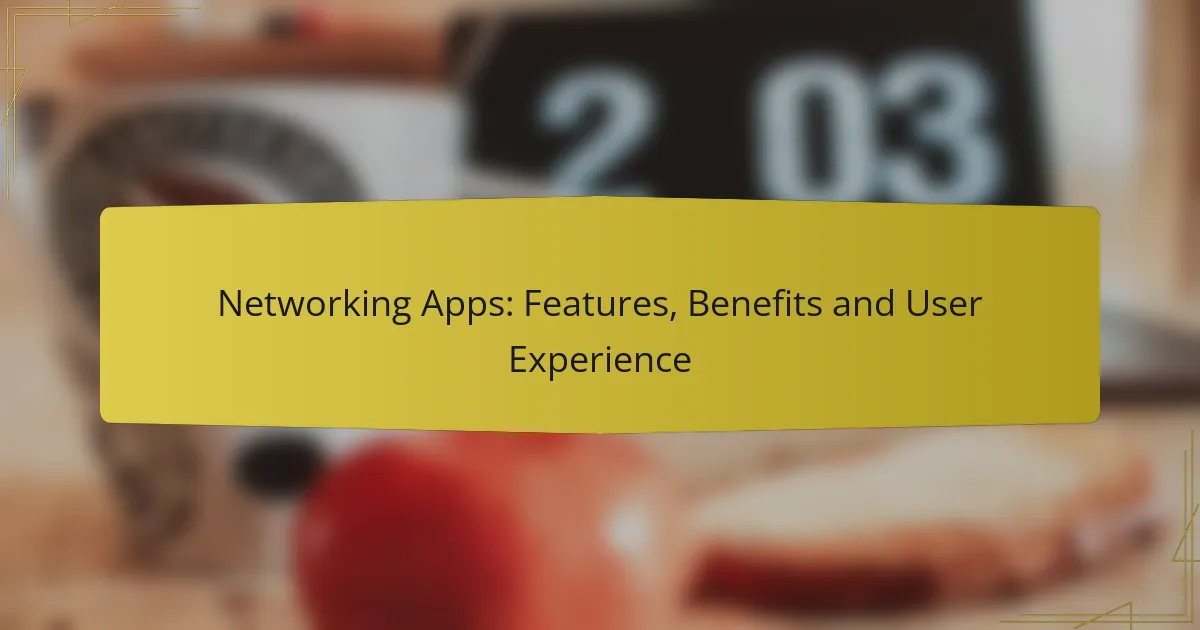Networking apps play a crucial role in connecting professionals across various industries, offering features that enhance collaboration and create new opportunities. By prioritizing functionalities such as user profiles, messaging, and event scheduling, these platforms cater to diverse networking needs, making it essential to choose one that aligns with your specific goals. Ultimately, they streamline communication and help users efficiently expand their professional networks.

What Are the Best Networking Apps for Professionals?
The best networking apps for professionals facilitate connections, collaboration, and opportunities within various industries. These platforms cater to different networking needs, from job searching to event organizing, making it essential to choose the right one based on your goals.
LinkedIn is the leading professional networking app, designed for career development and business connections. Users can create profiles showcasing their skills, experience, and endorsements, making it easier to connect with potential employers or collaborators.
To maximize your LinkedIn experience, regularly update your profile, engage with content relevant to your industry, and join groups that align with your professional interests. Avoid sending generic connection requests; personalize them to increase acceptance rates.
Meetup
Meetup is an app that helps users find and join local events based on shared interests, including professional networking. It allows professionals to connect in person, fostering relationships that can lead to job opportunities or partnerships.
When using Meetup, consider attending events that align with your career goals and actively participating in discussions. Be open to networking with diverse groups, as this can expand your professional circle significantly.
Bumble Bizz
Bumble Bizz is a feature of the Bumble app that focuses on professional networking, allowing users to connect with others in their industry. It operates similarly to dating apps, where users swipe to find potential business contacts.
To effectively use Bumble Bizz, create a compelling profile that highlights your skills and what you’re looking for. Engage with matches by initiating conversations and proposing collaborative ideas, as this can lead to fruitful professional relationships.
Shapr
Shapr is a networking app that connects professionals based on shared interests and goals, using a swipe-based interface. Users can create profiles that showcase their expertise and what they seek in networking, making it easier to find relevant contacts.
To get the most out of Shapr, be proactive in reaching out to matches and suggest specific topics for discussion. Regularly update your profile to reflect your current interests and goals, ensuring you attract the right connections.
Lunchclub
Lunchclub is an innovative networking platform that pairs professionals for virtual or in-person meetings based on mutual interests and goals. It aims to facilitate meaningful connections through curated introductions.
To leverage Lunchclub effectively, be clear about your objectives when setting up your profile. Participate actively in meetings and follow up with new contacts to build lasting professional relationships. Consider scheduling regular check-ins with connections to maintain engagement.

What Features Should You Look for in Networking Apps?
When selecting networking apps, prioritize features that enhance user interaction and facilitate connections. Key functionalities include user profiles, messaging capabilities, event scheduling, and integration with social media platforms.
User Profiles
User profiles are essential for establishing identity within networking apps. They typically include personal information, professional background, and interests, allowing users to present themselves effectively. Look for apps that enable customization of profiles to highlight skills and achievements.
Consider platforms that allow users to upload photos, share links to portfolios, or include testimonials. This can significantly enhance credibility and attract relevant connections.
Messaging Capabilities
Effective messaging capabilities are crucial for real-time communication and relationship building. Look for apps that offer direct messaging, group chats, and even voice or video calling features. These tools facilitate deeper interactions beyond initial introductions.
Ensure the app provides notifications for new messages and allows users to send multimedia content. This can enhance engagement and make conversations more dynamic.
Event Scheduling
Event scheduling features help users organize and participate in networking opportunities. Look for apps that allow users to create, share, and RSVP to events easily. This functionality is vital for coordinating meetups, webinars, or professional gatherings.
Consider apps that integrate calendar functionalities, enabling users to sync events with their personal schedules. This ensures they don’t miss important networking opportunities.
Integration with Social Media
Integration with social media platforms enhances the reach and effectiveness of networking apps. Look for apps that allow users to connect their profiles with LinkedIn, Facebook, or Twitter. This can streamline the process of sharing information and expanding networks.
Check if the app supports cross-posting or sharing updates directly to social media, which can increase visibility and attract more connections. This feature is particularly useful for professionals looking to showcase their expertise and engage with a broader audience.

What Are the Benefits of Using Networking Apps?
Networking apps offer significant advantages by facilitating connections, enhancing professional relationships, and streamlining communication. These platforms enable users to expand their networks efficiently, saving time while providing access to diverse communities.
Expanded Reach
Networking apps allow users to connect with individuals beyond their immediate circles, significantly broadening their professional reach. By leveraging these platforms, users can engage with industry leaders, potential clients, and collaborators from various locations.
For example, a marketing professional in Germany can easily connect with startups in the United States, creating opportunities for partnerships and collaborations that would be difficult to achieve through traditional networking methods.
Time Efficiency
Using networking apps can drastically reduce the time spent on building professional relationships. Instead of attending numerous events or meetings, users can connect with multiple individuals in a matter of minutes through messaging or virtual meetings.
To maximize time efficiency, users should prioritize their networking goals, focusing on specific industries or roles that align with their objectives. Setting aside dedicated time each week to engage with contacts can enhance productivity and ensure consistent networking efforts.
Access to Diverse Networks
Networking apps provide access to a wide array of networks that may not be available through traditional means. Users can join groups or forums that cater to specific interests, industries, or demographics, enriching their professional experience.
For instance, a software developer can join international tech communities, gaining insights and opportunities that reflect diverse perspectives and practices. This access can lead to innovative ideas and collaborations that benefit users in their careers.

How Do Networking Apps Enhance User Experience?
Networking apps enhance user experience by providing tailored connections, user-friendly designs, and timely updates. These features streamline interactions and foster meaningful relationships, making networking more efficient and enjoyable.
Personalized Recommendations
Personalized recommendations in networking apps use algorithms to suggest potential connections based on user interests, location, and professional background. This feature helps users discover relevant contacts they might not find otherwise, increasing the likelihood of valuable interactions.
For example, a marketing professional may receive suggestions for local entrepreneurs or industry events that align with their expertise. Users should regularly update their profiles to ensure recommendations remain accurate and beneficial.
Intuitive Interfaces
An intuitive interface is crucial for a positive user experience in networking apps. These designs prioritize ease of navigation, allowing users to quickly access features such as messaging, profiles, and event listings without confusion.
Apps that utilize clear icons, straightforward menus, and responsive layouts tend to retain users longer. When choosing a networking app, look for one that offers a seamless experience across devices, whether on mobile or desktop.
Real-Time Notifications
Real-time notifications keep users informed about new messages, connection requests, and event updates, enhancing engagement. This feature ensures that users do not miss opportunities to connect or participate in relevant discussions.
For optimal use, users should customize notification settings to avoid being overwhelmed while still receiving important alerts. Regularly checking notifications can lead to timely responses and stronger networking outcomes.

What Are the Key Considerations for Choosing a Networking App?
When selecting a networking app, consider factors such as user interface, target audience, features, and privacy settings. The right app should align with your networking goals and the demographics of your intended connections.
User Demographics
User demographics play a crucial role in determining the effectiveness of a networking app. Understanding the age, profession, and interests of the user base can help you choose an app that best fits your networking needs.
For instance, platforms like LinkedIn cater primarily to professionals, making them ideal for business networking. In contrast, apps like Bumble Bizz attract a younger audience looking for more casual connections. Assessing the demographics can guide you in selecting a platform that enhances your networking experience.
Additionally, consider the geographical distribution of users. Some apps may be more popular in specific regions, which can affect your ability to connect with local professionals or communities. Researching user demographics can help you avoid platforms that may not serve your networking objectives effectively.
